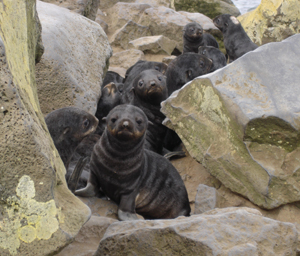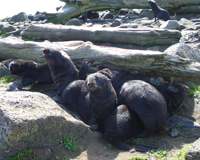NOAA Reports Northern Fur Seal Pup Estimate Decline
Lowest Birth Rate Since 1916
January 15, 2009

Northern fur seal pups on St. Paul Island, one of the Pribilof Islands. A temporary mark was applied to a pup (top right) by 'shearing' dark hairs off to expose lighter hair below.
High resolution (Credit: NOAA)
Researchers at the National Marine Mammal Laboratory of NOAA’s Alaska Fisheries Science Center have marked another decline in northern fur seal pup births in the Pribilof Islands in the Bering Sea, where most of the world’s population of northern fur seals gather in the summer to rest and breed.
“We started seeing an over-all decline in the abundance of fur seals on the Pribilof Islands around 1998, but we have not been able to identify the factors responsible,” said Dr. Doug DeMaster, center director. “While the population trends were up in specific areas and certain sectors of the population, the Pribilof Island pup count is a major marker, and it was down by 4.9 percent since the 2006 count.”
Analysis of 2008 data produced an estimate of 121,000 northern fur seal pups born in 2008. The total number of adult males counted on the Pribilof Island increased by 4.6 percent to 10,600.
Northern fur seals are considered depleted under the Marine Mammal Protection Act. The complexity of ecosystem interactions and limitations of data and models make it difficult to determine how fishery removals may have influenced this population. Other factors which may have contributed to past or present declines of northern fur seals include entanglement in marine debris, parasites and disease, pollutants, general nutrition, and predation.
“We have a very long, scientific record of the population of northern fur seals on the Pribilof Islands and not since 1916 have the islands produced this few seal pups,” said DeMaster. “Adult male counts began in 1909 and pup counts were initiated in 1912. At that time, the northern fur seal population was rebounding at a healthy eight percent per year, following the end of extensive at-sea seal hunting.”

Fur seal pups.
High resolution (Credit: NOAA)
The northern fur seal population rose steadily from the end of unregulated sealing into the 1950s, when scientists estimated the population at about two million. A harvest of adult females from 1956 to 1968 reduced the population through the 1970s. The total Pribilof population size stabilized briefly from about 1980 through the mid-1990’s but, since 1998, the population has declined at an annual rate of 5.2 percent.
While the Pribilof Islands are the main breeding and resting areas for northern fur seals, the seals also claim other, smaller breeding areas on Bogoslof, San Miguel, and South Farallon islands in the United States and in foreign waters on the Kurile, Commander, and Robben islands. Pribilof Island fur seals spend only the summer months foraging in the Bering Sea. During the rest of the year, they migrate south of the Aleutian Islands and forage at sea.
For 2008, researchers noted an overall population increase on the smaller of the Pribilof breeding islands, St. George Island, and that northern fur seals have also been increasing at Bogoslof Island in the nearby Aleutian Island chain.
The total population of northern fur seals in the whole Eastern Pacific stock was last estimated at 666,000.
NOAA understands and predicts changes in the Earth's environment, from the depths of the ocean to the surface of the sun, and conserves and manages our coastal and marine resources.